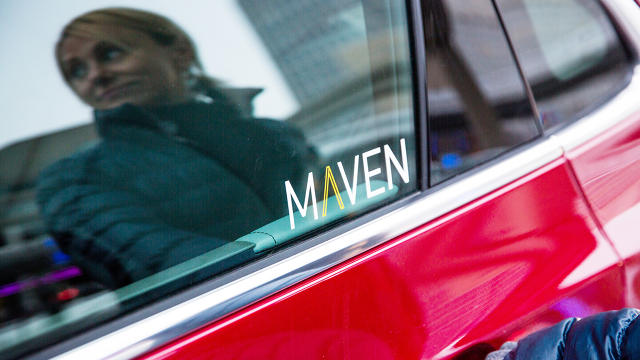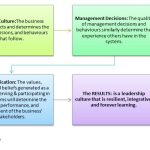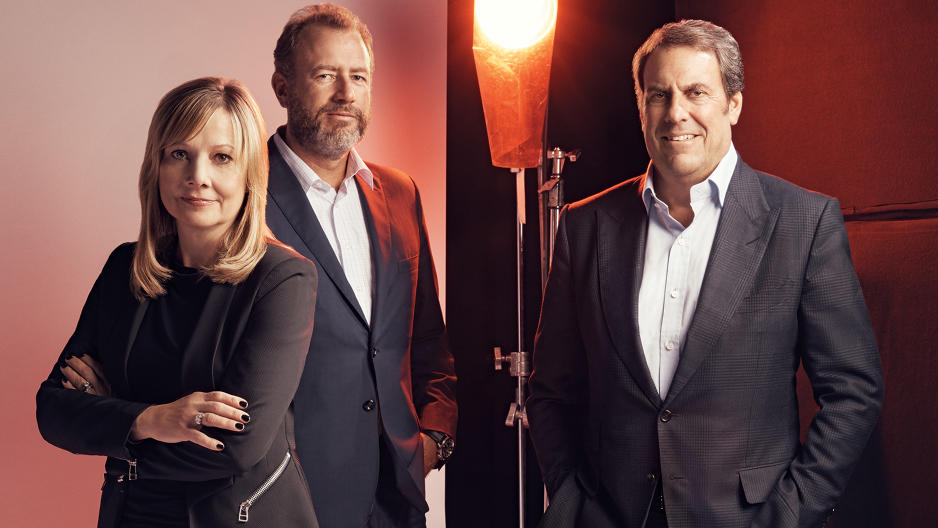Mary Barra Is Remaking GM’s Culture—And The Company Itself
General Motors CEO Mary Barra was walking the stage at the J.P. Morgan Automotive conference in New York on an early August morning, making a dramatic point-by-point case for the company she leads: that GM, despite all its challenges and varied competitors, just might be the strongest and most well-positioned business in all of automotive transportation.
And how did the audience of investors respond to Barra’s pitch? With seeming indifference. Indeed, many of the attendees appeared to be more engaged with their iPhones than the CEO’s presentation. It wasn’t just that lunchtime was approaching and blood-sugar levels were low, or that the meeting room’s drab brown-and-tan decor and muted acoustics had dulled everyone’s senses. No, the bigger obstacle was most likely an instinctive skepticism about GM itself—and, perhaps, about Barra, too. General Motors was once an acclaimed titan, the most respected company in America, but those days are long gone. Decades of decline have been punctuated by bankruptcy, a government bailout, and a devastating ignition-switch design flaw that has been implicated in 139 deaths. All of this solidified the notion that GM was a dysfunctional, bureaucracy-ridden has-been. If any business was likely to dominate the future of auto transport, it would be a Silicon Valley darling like Uber, Tesla, Google, or even Apple—all of which have been aggressively investing in disrupting the car business as we know it. They are the ones with the creativity, the talent, and the consumer passion to do something special. Not old-fashioned GM.
As for Barra herself—dressed in a conservative brown suit, speaking with a flat, slightly nasal Michigan accent—her stage presence didn’t exactly challenge this story line. The best she could do to liven up her less-than-dynamic delivery was chopping one hand into the other to punctuate her argument. A 35-year lifer at GM, Barra is a product of the exact company and culture that she is tasked with transforming. Perhaps it’s no surprise that GM’s valuation has dropped by about a quarter since she became CEO, the stock falling from $39 a share to a recent $32. If there is anything unexpected about her as a GM leader, it’s that she’s a woman (which, unfortunately, hasn’t always been viewed as an asset in the testosterone heavy auto world).
But here’s the wacky thing: What if all those reasons for doubting GM and dismissing Barra as something less than a Steve Jobs–like revolutionary . . . what if they are all wrong? A case of prejudice and assumption that misses some larger understanding? What if Barra is the perfect leader to reestablish GM as a premium, world-beating brand, outdueling all of those tech cowboys? Now that would be a story for the ages.
GM does have some things going for it, signs that it just might be a winner in the long-haul future of transportation—if things line up the right way. After Barra’s J.P. Morgan presentation, I met with her in a conference room upstairs in the bank’s offices, one of several meetings I’ve had with her and her top lieutenants over the past few months. Barra, an electrical engineer, doesn’t have the shiny bravado of so many tech-world leaders, but a career spent overseeing factories, supply chains, and GM’s entire product portfolio has given her a practicality they sometimes lack. She is much more at ease in person than she was on stage. When she explained that her father, who spent 35 years working as a die maker in a GM factory, taught her the value of hard work, it came off as authentic, not clichéd. She is keenly aware that GM’s 223,000 employees will have to behave differently if its plans for the future are to succeed; that she needs to replace a culture of blame and bureaucracy with one driven by accountability, speed, and collaboration. “In this area of rapid transformation, you have to have a culture that’s agile,” she said. “We still have a lot of work to do.”
GM could have gone away in 2009, disappeared. Yet today it is a profit machine, with some $20 billion in cash on its books. It has paid back more than two-thirds of the funds it received from the government, and for the last three consecutive quarters has reported solid results, including more than doubling its earnings in its June filing, to $2.9 billion. Just as critically, over the past year, GM has leaned into ride sharing, autonomous-driving technology, and electric vehicles at a heady pace. With a flurry of deals and product releases more reminiscent of its tech-industry competitors, GM has, in short order, constructed a portfolio of assets dedicated to disrupting its own core business from within.
What if Steve Jobs had been tasked with reviving a post-bankruptcy GM? What playbook would he have adopted? Looking back at Jobs’s return to Apple in 1997, he was faced with a financially strapped and dysfunctional operation. His first priority was to stabilize cash flow so he would have the resources to put toward innovation. This, too, was required at GM, and so far it has been successful. Jobs’s other priority was to make sure he had the right team in place around him and the right culture upon which to build. It wasn’t iPods or iPhones that Jobs obsessed about at that stage. It was the people. Only then could he turn himself to the products in earnest.
Barra has her own, similar obsessions. In Detroit a few weeks earlier, I had watched her deliver a far more impassioned—and successful—presentation in yet another dreary auditorium, in the bowels of Tower 300 of GM’s seven-building headquarters complex. This time Barra was speaking to 35 newly promoted mid-level executives, and they eagerly followed every word. “Remember your whole career, how you’ve been talking about them?” Barra said. “If only they would get it. If only they would work this out. Well, you are now they. If you don’t like something, you have to talk to yourself.”

Barra knows that she cannot succeed without turning around GM’s famously stagnant bureaucracy. This is a place, after all, that has long been known for its “GM nod” (agreeing to something in a meeting and then never doing anything about it) and “GM salute” (pinning blame on somebody else). “Look at what came out in the Valukas Report,” CFO Chuck Stevens told me, referring to a 2014 internal investigation of the ignition-switch crisis, which delivered a scathing indictment of GM’s management. “No sense of urgency. No accountability or responsibility. A siloed mentality.”
That kind of culture will never compete with Google and Uber. Barra has launched a slew of initiatives across the company designed to push GM in a new direction—from a program called GM 2020, which builds cross-functional “co-labs” to address all kinds of problems; to a yearlong “transformational leadership” course for senior execs; to a quarterly two-day off-site that Barra personally leads with her 16 top reports, focused not on strategy but on their own interactions. “Mary believes that if we change the behaviors [of top managers], people who work for us will see that and emulate it,” says HR chief John Quattrone. “There won’t be this dysfunction that we had before.”
Back in June, Barra had gone to San Francisco for her first test ride in one of GM’s new Bolt electric cars, which was equipped with the autonomous-driving technology of Cruise Automation, a company GM purchased earlier in the year for $581 million. Barra sat in the back seat with Cruise CEO Kyle Vogt and kept her eyes trained on two things: the busy streets of San Francisco and the technician up front, who was resting his fingertips lightly on the steering wheel, as is required by California regulations. Upstairs, under the broad wood beams of Cruise’s airy office, staff members gathered around a video monitor showing the car, which was marked by a flashing green light that moved around a digital map of the city. If something were to go wrong and the driver needed to grasp the steering wheel and quickly take control, the light would turn red, as it had on previous drives when the Bolt had shifted lanes. The crowd—and those two CEO passengers—was eager for that not to happen this time.
The drive was an important moment, symbolically and practically. Barra says GM started down “an evolutionary path” toward re-envisioning the company soon after it emerged from bankruptcy. At that point, under then-CEO Ed Whitacre, GM’s efforts at disruption had a me-too, late-to-the-party mien. GM launched its first hybrid car, the Volt, in 2010, significantly lagging behind hybrid pioneers such as Toyota. Still, Barra says, it was an important first step in acknowledging where the company needed to go. Over the next few years, GM began incorporating aspects of self-driving technology into select models, including software that alerts drivers if they veer out of their lane or stops the car if it detects an imminent collision. Many other car companies were also integrating features like this, but at least GM was in the game.
The evolutionary began tilting toward the revolutionary in late 2014. Barra had been appointed CEO earlier that year and pulled together a new group of leaders: former investment banker Dan Ammann, whom she named president; longtime GM exec Mark Reuss, whom she appointed product chief; and CFO Stevens. Together they dug into evolving data about the rise of ride sharing, the ambivalence of urban-dwelling millennials toward car ownership, and the appeal of all-electric vehicles. They looked at the economics: Shared self-driving cars might cut the cost of an average trip in half. And they started thinking about the daily experience of the 86% of Americans who commute to work by car. “Lots of people say they love to drive,” says Ammann. “But I haven’t met anyone yet who says they love their commute.” All those trends threatened the traditional car-selling business. While none of these factors were yet showing up in GM’s improving bottom line, Barra’s team concluded that without radical change, the road ahead would be rough. So how to turn these looming shifts into an opportunity?
What Barra was trying to do in that August J.P. Morgan presentation was lay out how quickly, radically, and effectively GM has put in place the plan it started hatching at the end of 2014. Spanning the arenas of connectivity, sharing, alternative propulsion, and autonomous technology, GM now has credible assets in each pillar of the business increasingly referred to as personal mobility. The company has, in short order, constructed a five-part portfolio, which arguably gives it as many or more of the necessary pieces to succeed in the driving world of tomorrow as anyone else:
1. The platform. While most people think of wireless connectivity as the purview of Silicon Valley, when it comes to the auto world, GM’s OnStar service provides both access and data that no other competitor has available. Historically, OnStar has been used by drivers to create an immediate connection to a live operator who can offer directions or help in an emergency. But moving forward, that platform will be applied to providing remote diagnostics, distributing software updates, and tracking data—not to mention managing autonomous fleets.
2. The partner. On January 4, GM announced a $500 million investment in Lyft, the country’s No. 2 ride-share service. The deal gives GM a foothold (it reportedly later passed on buying Lyft outright), allowing it to test, learn, and take advantage if ride sharing takes off even more. Already this year, the companies have worked together on a program called Express Drive, which lets Lyft drivers in seven big cities rent GM cars at heavy discounts, with other collaborations in the works.

3. The startup. Eleven days after the Lyft investment became public, GM announced that it would launch a proprietary car-sharing service called Maven. A Zipcar-like offering, Maven taps into another possible future of mobility: replacing ownership with sharing. This startup inside GM has some features Zipcar doesn’t—an app that lets you book, open, and start the car; free Apple CarPlay, Android Auto, OnStar, and 4G wireless in every car—and it is already operating in seven cities, with plans to expand significantly next year. At the same time, Maven lays the groundwork for a possible future when GM owns and operates a fleet of its own autonomous cars. It is a testing ground that can pivot as the marketplace does, even providing a backup brand that could be tapped for ride sharing in the event of Lyft’s demise or its outright purchase by a competitor.

4. The car. Barra believes GM’s new all-electric Bolt, which goes on sale later this year, will be a landmark product. When she and then-CEO Daniel Akerson initiated the Bolt project in 2013, the goal was to develop a fully electric vehicle that would be fun to drive, affordable, and practical, with a range of at least 200 miles (the minimum needed to make it viable for commuters, research shows). At a cost of just $30,000 (after a $7,500 federal tax rebate) and getting 238 miles from a single charge, the new car will far surpass the specs of competing electrics made by competitors such as Ford and Nissan. While the Bolt is similar in price and range to Tesla’s heavily anticipated Model 3, it will be available to consumers much earlier.
5. The technology. GM’s initial approach to autonomous driving was to incrementally add features to existing vehicles, gradually making drivers more comfortable with deferring to a computer. But when Ammann nailed down the acquisition of Cruise in March, it marked an investment into the more radical all-at-once strategy being pursued by the likes of Google and Uber. Launched in 2013, Cruise has built a complex array of software and hardware that uses artificial intelligence to pilot a car. While in-house GM engineers were working on their own fully autonomous system, Ammann and Barra came to believe that Cruise was further ahead—and so they jumped. Cruise CEO Vogt has been obsessed with self-driving cars since childhood, and designed his first autonomous vehicle for a state fair at the age of 13. When Vogt started Cruise, his goal was to sell autonomous-driving kits that could be retrofitted to regular cars. After he pivoted to the bigger idea of operating a fleet of autonomous cars, the shift put him right in line with the future as imagined by Ammann. Now GM and Cruise are working together to implement that vision at a huge scale: millions of customers, mostly young and urban, sharing rides in autonomous Bolt EVs.
Of course, Cruise’s technology actually has to work, which is why Barra’s test drive that June morning was so significant. Inside Cruise HQ, the mood was confident but tense, with little noise beyond the occasional iPhone ping. As the car navigated a particularly heavy stretch of traffic, it had to make a sudden lane shift. Barra and Vogt watched the driver’s hands; the Cruise staff watched the telemetrics monitor. The driver never grasped the wheel; the light stayed green.
After the car piloted itself back into Cruise’s garage, Barra and Vogt bounded into the office, triumphant. Barra stood in front of the assembled crowd. “If somebody [at GM] says you can’t have something, or you can’t do something, or it’s going to take this much time, and it doesn’t make sense to you, challenge them,” she told them. “I want to take the energy and speed and how you look at doing things and drive it into the core of GM.”
If there’s skepticism about GM, it is hardly without foundation. The basic components of autonomous, electric, shared rides are being pursued by many of GM’s competitors. Ford, for one, has announced plans to have a fully self-driving car (with no steering wheel) available by 2021, and is building its own stable of mobility-focused products and services. Uber launched a trial fleet of autonomous cars in September that is already ferrying paying passengers around Pittsburgh. Tesla’s ability to persuade 400,000 people to put down a $1,000 deposit on a Model 3 just from a press conference is eye-opening.
But what if we train that same lens of skepticism on the tech world? Suddenly, GM’s aspirations may not look so far-fetched. After years of development of self-driving cars and billions of dollars of investment, Google has little to show for it. And Apple, according to published reports this summer, may be rethinking its approach to making a car. Despite all of Silicon Valley’s astonishing accomplishments, it turns out putting together thousands of pounds of metal and plastic in a way that can safely move human beings at high speeds over great distances is, well, pretty hard to do. “[Google and Apple] generate a lot of cash, and have a lot of resources and talent, but neither one has made cars,” says Reuss. “The piece that is not well understood outside of the automotive industry is how hard it is to take technology and integrate it into a car. It seems like you should be able to layer it in and have it work and that would be great. Right. The effort to integrate that into the car is equal to or more than the technology itself. A car has to work right every time, all the time.”
Then there’s Tesla, which, with its high-profile Model S electric luxury car and the upcoming affordable Model 3, has been at the forefront of transportation’s transformations. But the company lost nearly $600 million in the first half of 2016, and two fatal Model S accidents have raised questions about the viability of its technology. While GM is sitting on some $20 billion in cash, Tesla is deeply in debt and seems likely to need a major infusion in order to achieve even its near-term goals. Despite its outsize reputation, Tesla delivered just 50,580 vehicles in 2015, compared to GM’s output of nearly 10 million. Elon Musk says Tesla will make 500,000 cars in 2018, but so far this year the company has missed its production goals. “Moving from producing tens of thousands of vehicles to hundreds of thousands of vehicles is a very significant challenge,” says Mike Ableson, who heads GM’s strategy group. “The Silicon Valley culture of developing fast and iterating fast can be a strength. But if you’re going to put this stuff in production, sooner or later you’ve got to turn it into hardware at high volume. That’s the Detroit side of the discussion.”
But what if that whole us-versus-them way of looking at it is wrong? Maybe, as the technology improves and consumer trends solidify, GM and the tech world won’t prove to be rivals after all. Perhaps they’re just different pieces of a larger puzzle—a future where Silicon Valley inspiration and Detroit know-how (and vice versa) converge in ways that yield transformative innovations we can’t yet imagine. “I don’t think any one company can do this all by itself, automotive or nonautomotive,” says Reuss. “That’s why you see acquisitions and partnerships happening.” In other words, GM could still be part of the mobility of the future even if all of this year’s new ventures fall flat.
For now, however, Barra isn’t thinking about that. She knows the work she and her team have done so far is just the beginning of a long process with many unforeseeable turns to come, but she’s determined to be first across the finish line. And like Steve Jobs and his renowned reality distortion field, the CEO believes that determination is as important as strategy. “Don’t confuse progress with winning,” she said while onstage at GM’s headquarters, discussing the company’s autonomous-car efforts. “It’s not like, ‘Check, check, check, done.’ It’s, ‘Okay, the table is barely set. This is a huge opportunity. So what are we going to do?’ ” In her vision of GM’s revved-up culture, Barra told the group, “best efforts” alone aren’t going to cut it. “Are you doing what you can?” she asked. “Or are you doing what it takes to win?”
related video: Ford’s CEO On The Future Of Connected And Autonomous Cars
A version of this article appeared in the November 2016 issue of Fast Company magazine.
Fast Company , Read Full Story
(119)














